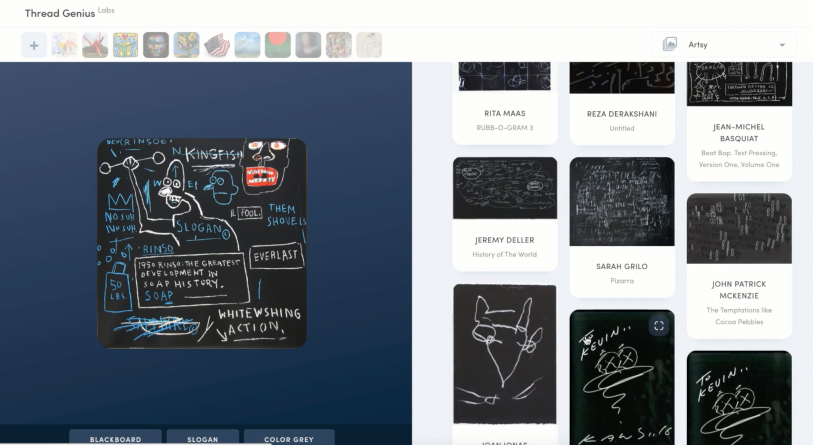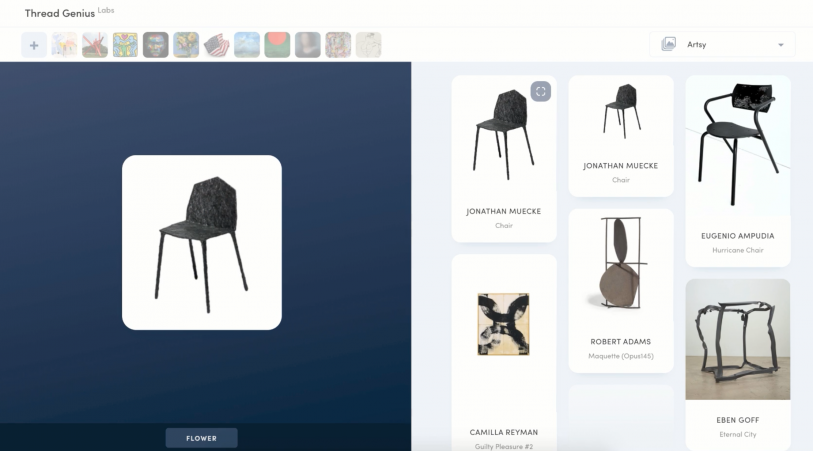Just a few doors down from its CEO and the wood-paneled cubicles where sharply dressed professionals sit, the eighth floor of Sotheby’s New York takes on a very different vibe.
Suddenly, it’s more Silicon Valley than Upper East Side as staid formality gives way to a group of millennials, some in T-shirts with their sneakered feet on desks. Computer code is scrawled on whiteboards and the room’s glass wall. It is here where the storied auction house–founded in 1744–meets its future.
Earlier this year, Sotheby’s made an interesting acquisition–and it wasn’t a Renoir. For an undisclosed sum, the company bought small AI startup Thread Genius as part of an unfolding long-term digital strategy. Its 12-member team includes Zocdoc, Zillow, and, perhaps most significant, Spotify.
The way Spotify suggests what music users might like based on previous plays, Thread Genius deploys complex algorithms to predict what art or luxury items clients may want to purchase based on previous purchases and searches. In short, it learns an individual’s personal tastes in art.
The goal is to improve recommendations to buyers and make it easier to purchase and sell pieces on the platform. The company is betting on its tech enterprise to both increase its supply of inventory and open its platform up to the middle market–people who are serious about collecting art but are not among the most high-end buyers.

The Spotify Connection
Thread Genius was conceived by Andrew Shum and Ahmad Qamar during their time as engineers working on music discovery and recommendations at Spotify. Qamar was one of the founding members of the music recommendations team responsible for the AI tech that creates the “Discover Weekly” playlists and artist recommendations.

“We crowdsourced the idea of music taste. When I was working there, we were looking at what it means to like music and what it means for two songs to be related,” Qamar says.
Thread Genius was founded in 2015 when Shum and Qamar realized that the recommendation techniques they were using to create playlists for people could be applied to other data-rich e-commerce fields such as fashion. The company had the original goal of clustering visually similar items together for the benefit of B2B clients.
It was only after working on an e-commerce platform that they began to think about applying AI and machine learning to art. “We started experimenting with artwork. We thought. ‘If I put a picture into our system, could we find similar images?’ ” Shum says.
Sotheby’s Global Vice President of Marketing and Strategy Noah Wunsch immediately saw an opportunity when he spotted the group on tech website Product Hunt, believing that the company could transform the art and luxury goods market.
https://vimeo.com/246948169
Taking a “taste fingerprint”
The comparison to Spotify can only go so far. While its users might listen to 40 songs in one day, customers at Sotheby’s generally only purchase one piece of art every few years. Shum and Qamar said that they consider a wide range of features, including visual features of the artwork, past searches, past purchases and what other people have bought and searched for. The team is also working with a database of 50,000 images of art, The Mei Moses Art Indices, which Sotheby’s acquired in 2016.
“In terms of getting someone’s taste fingerprint, we don’t just look at what they’re buying,” says Qamar. “We’re looking at every data point available to us. We don’t just have algorithms that look at similarities between images, we have natural language processing to look at image descriptions and find related artists.”
Shum says that in the future the team hopes it will be able to forecast art trends: “Say Zara makes a leather jacket and they want to figure out how it will sell, the company could look at a lot of transactional data–they could look at how many people buy it.”
He continues: “They could also ask a really stylish person who might be able to look at an item and predict pretty accurately if it is going to sell based on what they already know. We want to build something that can make predictions using everything it already knows.”
“We want to be able to look at visual features. Say I could look at your Instagram or your Pinterest, and recommend you a piece of art,” he added.
Sotheby’s recognizes that most high-end buyers don’t want the kinds of recommendations Thread Genius generates. If someone is looking for a Van Gogh and has the money to pay for it, they likely won’t settle for a similar painting by a different impressionist. This is particularly true when people purchase art as an investment.

Reaching the middle market
Wunsch says that the acquisition of Thread Genius is a play to expand the auction house’s reach beyond the high-end to the middle market.
“We want to provide recommendations for people who are interested in art and who might be looking for a piece but aren’t sure quite what it will look like yet,” he tells Fast Company. “Art can be investment for them, but they might also be looking for something they like to put in their homes.”
In addition to expanding its customer base, Sotheby’s is hoping that the platform will persuade more people to put items up for sale. “Unlocking supply is our number one priority right now,” Wunsch says.
“There’s a lot of art sitting in homes, and we want to provide a lower barrier to help people sell it if they want to,” adding that the current system of getting everything valued by experts and waiting for the right auction serves as a barrier to many people bringing works to market.
Providing better ways of using data to help items get valued is one of the team’s core initiatives. Sotheby’s employs an army of experts to provide a valuation for a piece but hopes the use of technology will speed up this process.
Thread Genius also wants to help people determine when the time is right to put their items up for auction. Shum cities the real estate company Zillow’s Zestimate application, which helps a homeowner estimate the value of their house and find the best time to sell it, as an inspiration. “If I own a house and I’m trying to figure out the best time to sell, there are tools to help me check that online. There isn’t anything like that for art yet.”
With Thread Genius, Sotheby’s is trying to remove another barrier to putting items up for sale: the annual auction calendar. Currently, some items can only get sold when they are included in a group of items, such as impressionist paintings. Thread Genius is hoping to help sellers put items to market items as soon as they decide they want to.
Shum explains: “Right now items are coming in and getting sold at certain times of the year. Say I have a Chinese porcelain vase that I want to sell, Sotheby’s might only have a couple of sales a year, so I’d have to wait. We’re looking at making a routing mechanism where that product can be pushed out to the right people, who can then buy it immediately.”
The Thread Genius features will roll out slowly across Sotheby’s platforms, but Wunsch anticipates they will have a big effect: “I think that in three years, what we’re building is going to disrupt the art and luxury market. There are a lot of people in the world who care about art, and we are hoping to help them buy and sell efficiently and discover art more easily through our platform.”
Recognize your brand’s excellence by applying to this year’s Brands That Matter Awards before the early-rate deadline, May 3.
